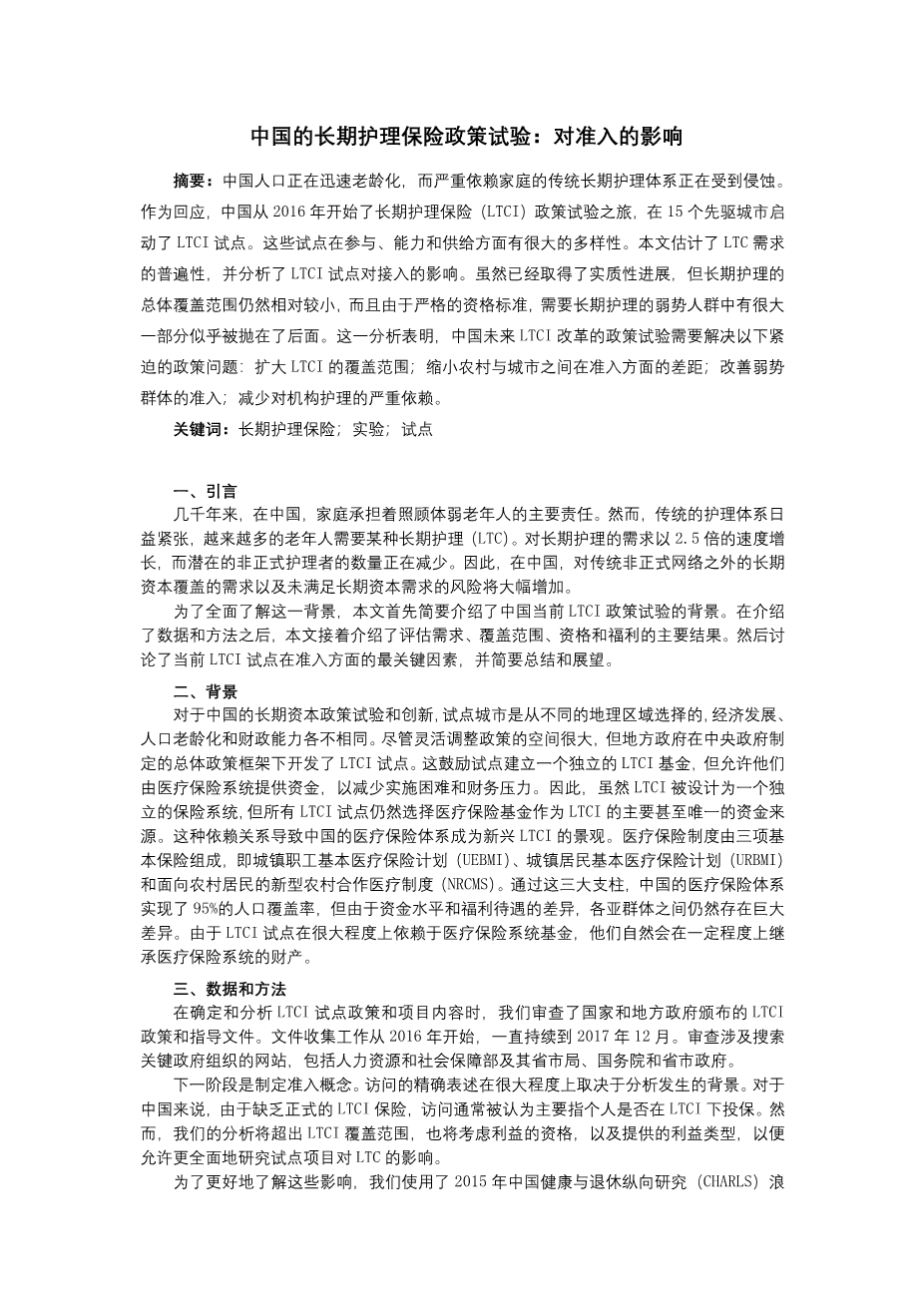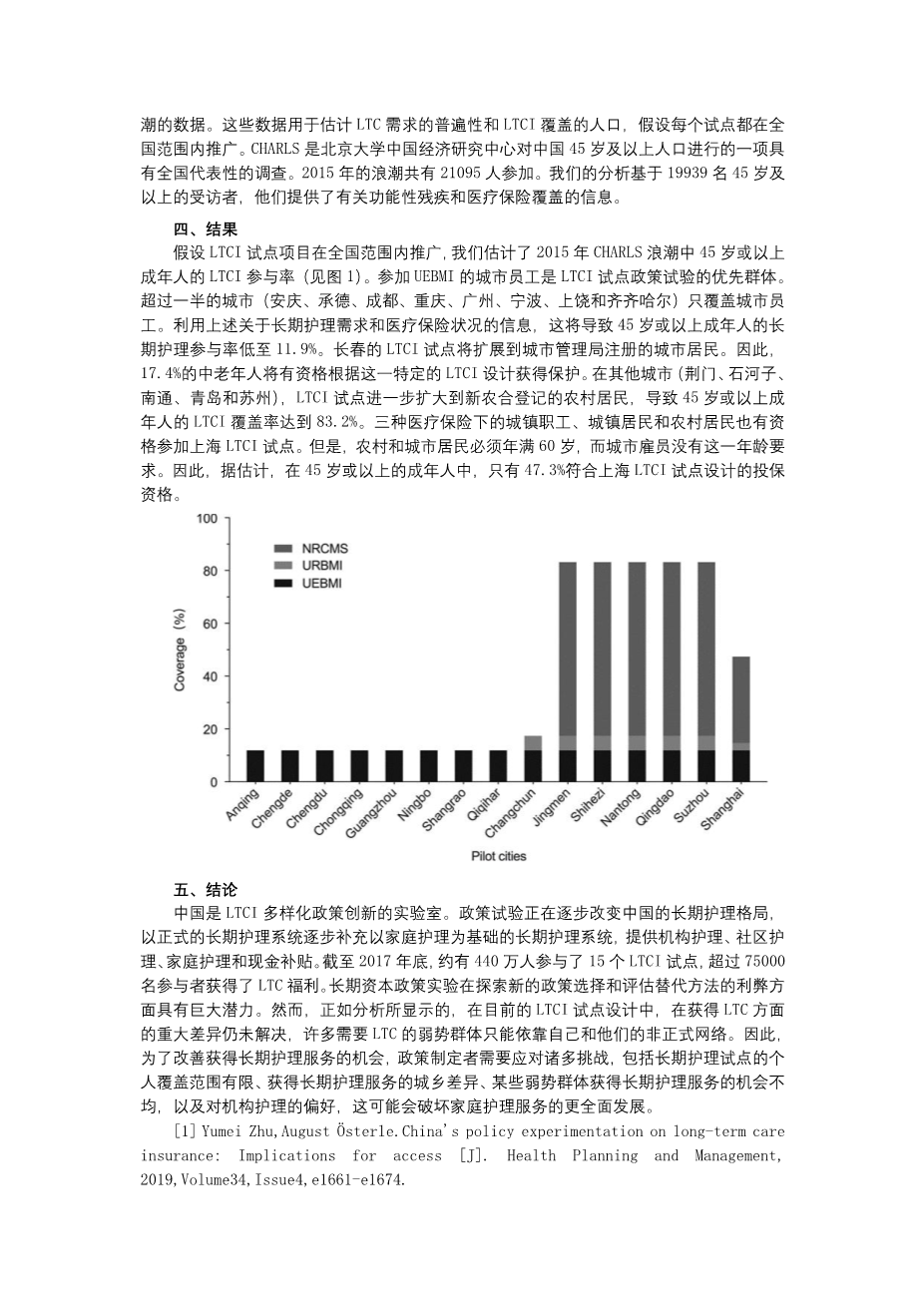Chinas policy experimentation on long-term care insurance: Implications for access
Abstract
Chinas population is aging rapidly, while the traditional long-term care (LTC) system that heavily relies on families is eroding. In response, China has embarked on a journey of policy experimentation for long-term care insurance (LTCI) since 2016, launching LTCI pilots in 15 pioneer cities. These pilots have a great diversity in participation, eligibility, and provision. This paper estimates the prevalence of LTC needs and analyzes the impact of the LTCI pilots on access. Although substantial progress has been achieved, the overall coverage of LTCI is still relatively small, and a large proportion of vulnerable people needing LTC seem to be left behind because of the strict eligibility criteria. This analysis suggests that future policy experimentation on LTCI reform in China needs to address the following pressing policy issues: expanding the coverage of LTCI; narrowing rural–urban disparities in access; improving access for vulnerable subpopulations; and reducing the heavy reliance on institutional care.
Keywords:long-term care insurance, experimentation, pilots
1 Introduction
For millennia, families have borne the main responsibility for caring frail older people in China. However, the traditional caregiving system is increasingly strained, and a growing number of older people need some kind of long-term care (LTC).The demand for LTC is growing by a factor of, while the pool of potential informal caregivers is shrinking. Hence, the need for LTC coverage outside traditional informal networks and the risk for unmet LTC needs will grow substantially in China.
To allow for a full picture of the context, the paper starts by briefly introducing the background of Chinas current policy experimentation on LTCI. After introducing data and methods, the paper proceeds with introducing the main results for estimating needs, coverage, eligibility, and benefits. This is then followed by a discussion of the most critical factors of the current LTCI pilots in terms of access and a brief conclusion and outlook.
2 Background
For LTC policy experimentation and innovation in China, pioneer cities were selected from diverse geographical regions, with variations in economic development, population aging, and fiscal capacities. Despite substantial space for flexible policy tailoring, the subnational governments developed LTCI pilots under an overall policy framework set by the central government. This encourages pilots to establish a stand-alone LTCI fund but allows them to be financed by the medical insurance system for reducing implementation difficulties and financial pressure. As a result, while LTCI is designed as an independent insurance system, all LTCI pilots still opt for medical insurance funds as the principal, and even the sole, funding source of LTCI. This dependency relationship results in the fact that Chinas medical insurance system acts as the landscape of emerging LTCI. The medical insurance system consists of three basic insurances, namely the urban employee basic medical insurance scheme (UEBMI), the urban resident basic medical insurance scheme (URBMI), and the new rural cooperative medical system (NRCMS) for rural residents.Via these three pillars, Chinas medical insurance system has achieved 95% coverage of the population, while large disparities still exist among subpopulations because of the differences in the funding level and in the benefit packages.Since LTCI pilots largely depend on the funding pools of the medical insurance system, they naturally inherit properties of the medical insurance system to some extent.
3 Dataand Methods
In identifying and analyzing LTCI pilot policy and program content, we reviewed LTCI policy and guidance documents enacted by the national and subnational governments. The collection of documents took place from 2016 till December 2017. The review involved a search of the websites of the key governmental organizations, including the Ministry of Human Resources and Social Security and their provincial and municipal bureaus, the State Council, and the provincial and municipal governments.
The next stage is to formulate the concept of access. The precise formulation of access is highly contingent on the context where the analysis is taking place.For China, given the lack of formal LTCI coverage, access is often considered to primarily refer to whether or not the individual is insured under LTCI. However, our analysis will go beyond LTCI coverage and will also consider eligibility for benefits, and the type of benefits provided in order to allow for a more comprehensive study of the impacts of the pilot programs on access to LTC.
In order to better understand these impacts, we use data from the 2015 wave of the China Health and Retirement Longitudinal Study (CHARLS). The data are used to estimate the prevalence of LTC needs and the population covered by LTCI, assuming a nationwide roll-out of each of the pilots. CHARLS is a nationally representative survey of the Chinese population aged 45 and older and is conducted by the China Center for Economic Research at Peking University. In total, 21 095 individuals participated in the 2015 wave. Our analysis is based on 19 939 respondents aged 45 and older who provided information on functional disabilities and medical insurance coverage.
4 Results
We estimate LTCI participation rates among adults aged 45 or over from the 2015 wave of CHARLS, assuming that the LTCI pilots are rolled-out nationwide (see Figure 1). Urban employees enrolled in UEBMI are the priority group to be covered by LTCI pilots in the policy experimentation. More t
剩余内容已隐藏,支付完成后下载完整资料


英语译文共 2 页,剩余内容已隐藏,支付完成后下载完整资料
资料编号:[591226],资料为PDF文档或Word文档,PDF文档可免费转换为Word


